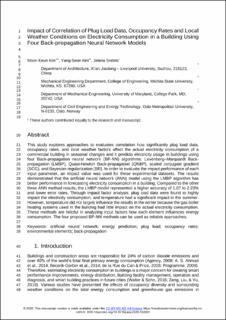| dc.contributor.author | Kim, Moon Keun | |
| dc.contributor.author | Kim, Yang-Seon | |
| dc.contributor.author | Srebric, Jelena | |
| dc.date.accessioned | 2021-08-31T11:30:06Z | |
| dc.date.available | 2021-08-31T11:30:06Z | |
| dc.date.created | 2020-09-08T22:42:03Z | |
| dc.date.issued | 2020 | |
| dc.identifier.citation | Sustainable Cities and Society (SCS). 2020, 62:102321 1-10. | en_US |
| dc.identifier.issn | 2210-6707 | |
| dc.identifier.uri | https://hdl.handle.net/11250/2771946 | |
| dc.description.abstract | This study explores approaches to evaluates correlation how significantly plug load data, occupancy rates, and local weather factors affect the actual electricity consumption of a commercial building in seasonal changes and it predicts electricity usage in buildings using four Back-propagation neural network (BP-NN) algorithms: Levenberg–Marquardt Back-propagation (LMBP), Quasi-Newton Back-propagation (QNBP), scaled conjugate gradient (SCG), and Bayesian regularization (BR). In order to evaluate the impact performance of each input parameter, an impact value was used for these experimental datasets. The results demonstrated that the artificial neural network (ANN) model using the LMBP algorithm has better performance in forecasting electricity consumption in a building. Compared to the other three ANN method results, the LMBP model represented better performance with a lower error rate of 1.07–2.23%. Through impact factor analysis, plug load data were found to highly impact the electricity consumption, and temperature had a significant impact in the summer. However, temperature did not largely influence the results in the winter because the gas boiler heating systems used in the building had little impact on the actual electricity consumption. These methods are helpful in analyzing input factors how each element influences energy consumption. The four proposed BP-NN methods can be used as reliable approaches. | en_US |
| dc.language.iso | eng | en_US |
| dc.publisher | Elsevier | en_US |
| dc.rights | Attribution-NonCommercial-NoDerivatives 4.0 Internasjonal | * |
| dc.rights.uri | http://creativecommons.org/licenses/by-nc-nd/4.0/deed.no | * |
| dc.subject | Artificial neural networks | en_US |
| dc.subject | Energy prediction | en_US |
| dc.subject | Plug load | en_US |
| dc.subject | Environmental elements | en_US |
| dc.subject | Back-propagation | en_US |
| dc.title | Impact of correlation of plug load data, occupancy rates and local weather conditions on electricity consumption in a building using four back-propagation neural network models | en_US |
| dc.type | Peer reviewed | en_US |
| dc.type | Journal article | en_US |
| dc.description.version | acceptedVersion | en_US |
| cristin.ispublished | true | |
| cristin.fulltext | original | |
| cristin.fulltext | postprint | |
| cristin.qualitycode | 1 | |
| dc.identifier.doi | 10.1016/j.scs.2020.102321 | |
| dc.identifier.cristin | 1828229 | |
| dc.source.journal | Sustainable Cities and Society (SCS) | en_US |
| dc.source.volume | 62 | en_US |
| dc.source.issue | 102321 | en_US |
| dc.source.pagenumber | 1-10 | en_US |

